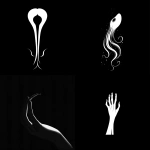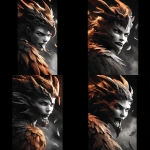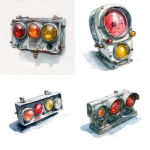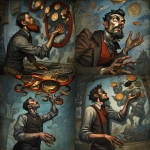Explore the Best AI Image Gallery

Beyond the Brush: How AI is Transforming Graphic Design
The realm of graphic design is undergoing a seismic shift, driven by the rapid advancements in artificial intelligence (AI). No longer confined to science fiction, AI is now actively reshaping the creative landscape, empowering designers with unprecedented tools and capabilities. This evolution promises to democratize design, streamline workflows, and unlock new frontiers of visual expression. However, this technological revolution also raises important ethical considerations that demand careful attention.
AI-Powered Design Tools: A New Creative Arsenal
A plethora of AI-powered tools are emerging, each offering unique functionalities to enhance the design process. Some key applications include:
- Generative Design: AI algorithms can generate multiple design variations based on specific parameters and preferences, helping designers explore a wider range of options and discover innovative solutions.
- Image Editing and Enhancement: AI-powered tools can automate tedious tasks such as removing backgrounds, enhancing image resolution, and correcting color imbalances, freeing up designers to focus on more creative aspects.
- Typography and Layout Optimization: AI can analyze text content and suggest optimal font pairings, layouts, and hierarchy, ensuring readability and visual appeal.
The Democratization of Design
One of the most significant impacts of AI in graphic design is its potential to democratize the field. By automating complex tasks and providing accessible tools, AI empowers individuals without formal design training to create professional-quality graphics. This opens up new opportunities for entrepreneurs, small businesses, and anyone looking to express their creativity visually.
Ethical Considerations: Navigating Uncharted Territory
While the potential of AI in graphic design is immense, it also raises ethical concerns that require careful consideration:
- Copyright and Intellectual Property: AI-generated designs raise questions about ownership and copyright. Its crucial to establish clear guidelines and regulations to protect the rights of both creators and users of AI-powered tools.
- Bias and Fairness: AI algorithms are trained on vast datasets, which can inadvertently perpetuate existing societal biases. Designers must be aware of this potential and strive to mitigate bias in their use of AI tools.
- Transparency and Explainability: The decision-making processes of some AI models can be opaque, making it difficult to understand how they generate designs. Increased transparency and explainability are essential for building trust and accountability.
The Future of Graphic Design: A Human-AI Collaboration
Looking ahead, the future of graphic design lies in a harmonious collaboration between human creativity and AI technology. AI will continue to augment the capabilities of designers, automating tasks, providing insights, and expanding creative possibilities. However, the core essence of design—the ability to empathize, understand human needs, and communicate effectively—will remain uniquely human.
Designers who embrace AI as a powerful tool, while honing their critical thinking, problem-solving, and storytelling skills, will be well-positioned to thrive in this evolving landscape. The synergy between human ingenuity and AI intelligence promises to usher in a new era of groundbreaking design that is both innovative and meaningful.

](https://images.ai-img.art/thumbnails/150/3c5dc62bba83cc9919c20ebfec8430d31e821cef586a2753dd85ef26d77d480a.webp)



](https://images.ai-img.art/thumbnails/150/3e8c063b4357fc743a3c6e49a3145ee31b2dcecc018c38d2db8f97bf3e3fda3f.webp)
](https://images.ai-img.art/thumbnails/150/8c320ce9aefbbb5b9ec5fd4e1d0fba7388f0fff5b6c2e2f14077cad3008f291d.webp)

](https://images.ai-img.art/thumbnails/150/1d7b3a908141474d50d90721c394db29c0cb5404d685ae70ea60430c18e905b7.webp)


](https://images.ai-img.art/thumbnails/150/1accb5453f2335686b162f0a879c7ce73a18516a33868f214a16bdaf95beeb5a.webp)











